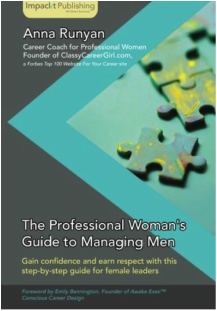Anna Runyan’s book, “The Professional Women’s Guide to Managing Men” provides a number of useful strategies, tips and evaluation activities for each chapter, to manage men in workplace. The author sets out to identify the inherent traits of a woman and indicate how each one of them can be used beneficially, and if these traits can be hurtful when managing men. The interactive narrative style is the hallmark of this book and powerfully engages readers. The readers can evaluate themselves throughout their journey with this book. The author provides several examples from her own life experiences in handling specific situations and she talks about strategies that worked for her. Notably, in the first chapter she describes a scenario where a man questioned her knowledge and expertise, and how she handled this situation assertively.
Regardless of the type of interaction with the male - whether it is your male boss, co-worker, those you lead, or even a family member or spouse – this book helps understand these interactions. However, the author bases her narrative on the assumption that men and women are psychologically different, with different stereotypes, which I do not completely agree with. Nonetheless, you should carefully observe the men you are leading, working with or working for, before forming any preconceived notions about their traits. Thus, instead of blindly following this book, I would suggest that you exercise caution and learn a person’s traits by trial-and-error. For instance I find both women and men can be detail-oriented, especially those working in a technical field. Similarly, building trust is equally important for women and men – open conversations and transparency helps build trust with an unfamiliar person. Runyan has devoted an entire chapter on how to be a confident manager. She explains the importance of assertiveness and she alerts the readers to “Be aware that being assertive isn’t the only goal; it is being assertive and smart.” I cannot agree more with Runyan about adopting a professional dress-code and manner in the workplace. Additionally she also encourages women to take an interest in what might be deemed ‘manly interests’. For instance, even if you don’t love or follow sport, she suggests that women should “at least know what is going on and who is winning and losing” as “men and not women initiate sports-talk 85% of the time in the office”. She says that this will enable women to understand how men in the team compete and provide more insight into their behavior in the office. As women have more common in common to share with other women, some extra effort might be required for women to understand men. In general, this book can teach professionalism for women at work, regardless of if they play a managerial role. This book is a good addition to the personal library and can be useful at any point in your career. The points covering the constructive use of men’s spirit for competition and negotiation with men particularly drew my attention. However, while this book makes an excellent reference for personal evaluation, I would not recommend it as a one-on-one guide. Note: The reviewer of the book is an established materials research scientist herself and I share her belief that learning to manage both men and women effectively is critical for women scientists to boost the number of women leaders in STEM fields. References 1. E.K. Clint et al., Q. Rev. Bio., 87 (2012) 289 Comments? Leave them below! 
About the Author
Dr Vijayalakshmi (Viji) Kalyanaraman is a surface scientist and freelance science writer. After receiving her PhD from the University of Hamburg in Germany, she worked as a postdoctoral research scientist at Argonne National Laboratory, investigating astrochemical reactions applying her surface science skills to understand the origin of life on earth. She studied the reaction mechanisms in thin film amino acids, of DNA as well as of organic molecules by bombarding with soft x-rays from advanced photon source. After her postdoctoral appointment, she took a break to care for her child. She is now a contributing writer for Scientista, while also engaging in independent science writing.
0 Comments
Your comment will be posted after it is approved.
Leave a Reply. |
LIFESTYLE BLOGRead our lifestyle advice, written exclusively for pre-professional women in science and engineering. From advice about fashion, work and family balance, self, wellness, and money, we've got you covered! |
The Scientista Foundation, Inc. All Rights Reserved © 2011-2021 | Based in NY | [email protected]
The Network for Pre-Professional Women in Science and Engineering
The Scientista Foundation is a registered 501(c)(3) -- Donate!
The Network for Pre-Professional Women in Science and Engineering
The Scientista Foundation is a registered 501(c)(3) -- Donate!

